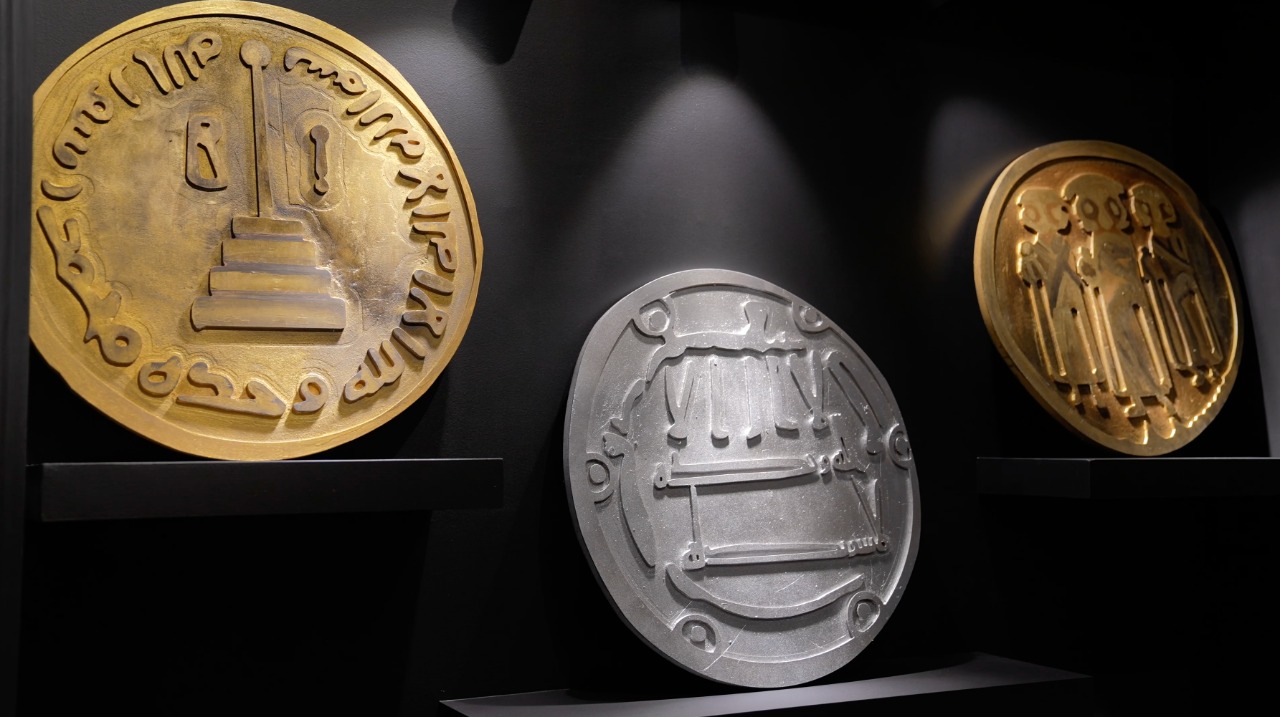Owning the first Arab Islamic dinar that was minted in the year 72 AH
The King Abdulaziz Public Library in the Saudi capital, Riyadh, owns the first Arab Islamic dinar that was minted during the reign of the Umayyad caliph Abdul Malik bin Marwan in the year 72 AH, (692 AD). It is struck in non-Muslim countries.
It is the first Arab and Islamic currency on which the Certificate of Monotheism is written, as it included the face of the dinar: “A column standing on four steps ending at the top with a small ball to the right and left. Greek writing (Iota Beta) was inscribed and indicates the number (12) and in the margin: In the name of God, there is no god but God. God alone, Muhammad is the Messenger of God) and on the back of the dinar, “a picture of three people symbolizing the Byzantine Emperor and his two sons wearing Arab clothes, different from the Byzantine clothes that appear on the Byzantine dinar.” The weight of the dinar is (3.1 g) and its diameter is (18.3 mm).
The minting of dinars began in the beginning in the style of the Byzantine bronze coins, which represented Heraclius, the ruler of the Romans, and his two sons, and were struck at the mint in the city of Alexandria. 705 AD) starting from the year 72 AH.
The book, which was issued by the King Abdulaziz Public Library and prepared by Dr. Nayef bin Abdullah Al-Sharaan, includes a review of (300) rare Islamic coins selected from the collections of coins and coins in the library, which amount to more than (8100) coins of gold, silver and other metals, which cover all Islamic periods to reach The temporal coverage extends to fourteen centuries or more, from the early Islamic eras to the present time, in addition to the large geographical coverage to include: India and Central Asia in the east, to Morocco and Andalusia in the west, and from the Caucasus in the north to Yemen and Oman in the south.
Some specialists have counted these holdings as one of the most important and distinguished collections preserved in the Kingdom of Saudi Arabia, as the library holds rare Arab and Islamic coins dating back to the Umayyad, Abbasid, Andalusian, Fatimid, Ayyubid, Atabeg, Seljuk, and Mamluk eras, and from the countries of the Islamic Levant, the Maghreb countries, and even the Ottoman era.
Most types of Islamic money held by the library are characterized by global scarcity, and there is no equivalent of it yet. Among these pieces: the Sasanian Arab dirham minted in Damascus in the year 75 AH, and the Abbasid dirham minted in the city of Basra in the year 140 AH during the reign of the Caliph Abi Jaafar al-Mansur. This dirham is distinguished from Other than the dirhams of the Caliph Al-Mansur in general and the Abbasid dirhams minted in the city of Basra, with the presence of the word (slave) below the writings of the center of the face, a word that had never appeared on the dirhams of this caliph before.
This dirham is an important addition to the collection of the King Abdulaziz Public Library. The collections also include: the Tulunid dinar minted in Palestine in the year 292 AH, the Mecca dinar in the year 451 AH, the stumbled dinar minted in the year 338 AH, and the Buyid dinar minted in the Daylam chair in the year 587 AH, in addition to some coins that express The civilizations that lived in the Arabian Peninsula and which were minted in the cities of minting money in the Arabian Peninsula in Mecca, Medina, Yamama, Bisha and other cities.
The Rare Coins Project lists all the preserved holdings of the King Abdulaziz Public Library of rare, historical, Islamic, Saudi and other coins, indexes and classifies them using the scientific methods used in classifying international collections, prepares a database of its own, includes all the basic data for each piece separately, and enters it. In its own automated system, so that it is available to researchers and specialists who are pioneers of the library.
Islamic coins are among the most important sources of Islamic history, as they include information expressing the religious, political, economic, social and artistic events that the Islamic state witnessed at the time of their issuance. The study of Islamic coins is one of the most important historical and cultural studies.
#coins #King #Abdulaziz #Public #Library #Islamic #eras #AlHiwar #Algeria
#oussama_boulegheb #elhiwardz #alakhibariat.xyz #elhiwar #elhiwar-en



